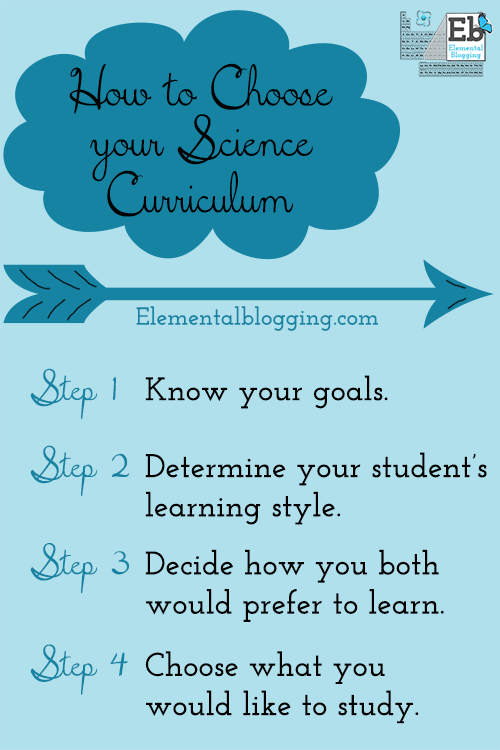 As homeschoolers, many of us adhere to a certain learning philosophy, such as classical or interest-led. These methods give us a basic framework for choosing curricula, but it can still be a challenge to find the one specific curriculum that fits your particular family.
As homeschoolers, many of us adhere to a certain learning philosophy, such as classical or interest-led. These methods give us a basic framework for choosing curricula, but it can still be a challenge to find the one specific curriculum that fits your particular family.
Every family has different goals and learning styles, which means that no one homeschool science curriculum can fit every situation.
So how do you wade through all of the choices?
Here are a few tips to help you as you seek to choose materials that will work for your student:
Step 1. Determine your goals.
As with any homeschool subject, you need to first determine your goals for teaching science. Ask yourself…
- What do I have to prepare my student for? For instance, if you plan on preparing your student for college, it’s good to know what science he will be required to complete in high school. That way you can begin to introduce those subjects much earlier.
- What do I want to instill in my student about science? For example, “I want my student to fall in love with nature.” or “I want my student to get excited about science.”
- Is there anything that you must teach your student? For instance, if you plan on sending your student back to school the following year, you will need to make sure that they are prepared to go to the particular school in time.
It’s good to have both realistic long range and short range goals.
Step 2. Know your student’s learning style.
It is important to understand how your student prefers to learn so that you can choose homeschool science curriculum that will maximize your teaching efforts. A student can have one type of learning style across the board or they can blend several types to create their own style. There are four basic learning styles:
- Visual: This type of student needs to see things before he picks up on the information.
- Auditory: This type of student learns best from hearing, either from read-alouds, lectures or discussions.
- Tactile: This type of student needs to touch things. He best acquires information from tangible processes.
- Kinesthetic: This type of student learns best when he is moving.
As your student gets older, you do need to stretch them by teaching them how to learn from materials that are outside of their preferred learning mode.
It’s also important to note, that you can alter most homeschool science curriculum to fit your student’s learning styles. However, it is important to know this information before choosing because not all curricula can be molded to fit your particular student.
Step 3. Decide how you would prefer to learn.
Now that you know your goals and learning styles, it is easier to determine how you should go about studying science. You can ask yourself the following questions:
- Would we prefer to learn about science from a textbook, encyclopedia or living book? If you want to learn more about the differences between these three types of materials, read my article What are living books?
- Would we prefer to learn about science outdoors or through indoor scientific tests? For example, those who prefer learning outdoors will do very well with a curriculum that promotes nature study.
- Would we prefer to learn about science through notebooking or through worksheets? I have written about the benefits of notebooking before, but some students will thrive on a just the fact worksheet-style approach.
- Would we prefer to enrich our science study time with hands-on learning projects? A craft project is a great way to reinforce what the student is learning, but it can also lead some students towards frustration which would not be conducive for learning science.
- Would we enjoy spending one year on one area of science or would we prefer to pick and choose units? Within an area of science, like biology, you can jump around on topics, such as animals, plants and the human body. Even so, it is also acceptable to do a little biology, a little physics and a little earth science all in one year.
Knowing how you would like to study science will help you to determine which homeschool science curriculum will best fit your needs.
Step 4. Choose what you would like to study.
Sometimes your learning philosophy will help you to choose what to study, sometimes your student will determine what they would like to learn for the year. Either way you can ask yourself two questions to help determine what to look for in a homeschool science curriculum:
- What would I like to see my student learn this year? Your learning philosophy may already have set guidelines for what to teach each year or you may have certain benchmark concepts that you would like your student to know by a specific time. Writing out what (if anything) you want your student to learn in a particular year, will help you determine which curriculum to choose.
- What would my student like to study this year? It is perfectly acceptable to ask your student what they would like to learn. After all, if they are interested in the subject matter, they will be more likely to engage with the materials and retain the information that they are studying.
You also need to determine which of the above answers on which you will place more emphasis.
Now that you are armed with your goals, your student’s learning styles, what you would like to study and how you would like to approach learning that information, you are ready to tackle the multitude of options that are before you!
If you need more assistance in determining your goals for teaching homeschool science or with knowing how and what to teach for science, please check out our book, Success in Science: A Manual for Excellence in Science Education.
 Sign up below to receive weekly tips & tools for homeschool science and we'll send you a FREE copy of
Sign up below to receive weekly tips & tools for homeschool science and we'll send you a FREE copy of 